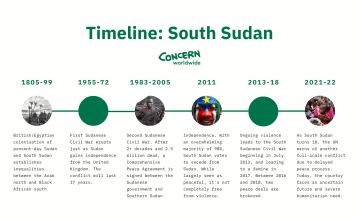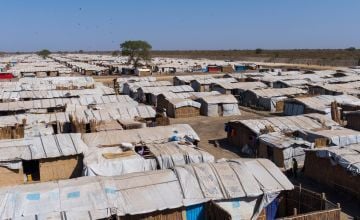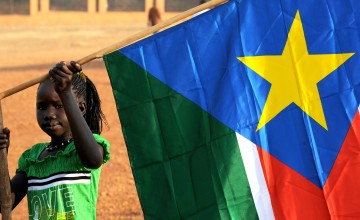
Read our 2023 annual report

Knowledge Hub
South Sudan hasn’t known peace since it became an independent nation in 2011. To better understand the country’s crisis in 2022, here’s an at-a-glance look at its history over the last two centuries.

1805-1899: Egyptian conquest and British colonisation
The area comprising present-day Sudan and South Sudan was subject to conquest and colonisation for millennia. In the early 16th Century, the Ottoman Empire and Funj Sultanate conquered much of the former Nubian Empire, and historians point to the reign of Muhammad Ali of Egypt as a key turning point in the Sudanese slave trade.
Geographical boundaries, including the White Nile River, led to a majority-Arab north Sudan and a largely Black African south, and slave raids in Sudan were largely focused on the southern region of the territory. The British attempted to abolish slavery in the region as they began to take power throughout the 19th Century. These were largely ineffective (and helped undermine development in the south).

At the turn of the 20th Century, the United Kingdom and Egypt struck a joint-governance agreement that left Sudan effectively a British colony. This made abolition efforts more successful. However, British officials and missionaries focused their resources on the north, to the exclusion of the historically-marginalised south, which left the territory chronically underdeveloped in terms of education, healthcare, and even basic infrastructure.
1947-1956: Unification and independence
Nearly 50 years later, at a conference in what is now the South Sudanese capital of Juba, an advisory council agreed to more fully integrate governance of southern provinces with the north. Five years later, the Egyptian Revolution removed British influence over the country and, because of the previous arrangement between both countries, also led to Sudan gaining independence from both Britain and Egypt. This agreement was reached in October, 1954, and took effect on January 1, 1956.
1955-1972: The First Sudanese Civil War
History isn’t always sequential. Four months before Sudan’s official independence, the First Sudanese Civil War broke out, with the Sudanese government representing the north and a unified separatist movement pushing to make the south an independent state. The conflict lasted for 17 years, until an agreement signed in Addis Ababa, Ethiopia, led to the creation of the Southern Sudan Autonomous Region (SSAR).
1983-2005: The Second Sudanese Civil War
In 1983, Sudanese president Gaafar Nimeiry declared the country an Islamic state and revoked the autonomy of the majority-Christian SSAR. The Second Sudanese Civil War broke out in response to this, although the southern coalition was split into more factions this time, largely dividing along ethnic lines. More South Sudanese died due to local infighting than at the hands of northern forces, including the brutal Bor Massacre of 1991 and a resulting famine which, combined, claimed the lives of an estimated 27,000. At 22 years, it was the longest civil war in African history.
After more than two decades of conflict and casualties exceeding 2.5 million, a Comprehensive Peace Agreement was signed in Nairobi in 2005 between the Sudanese government and Southern Sudan. Southern Sudan was made a semi-autonomous region and guaranteed a referendum on independence within six years. After the death of Sudanese Vice President John Garang, South Sudanese politician Salva Kiir Mayardit was appointed both Vice President of Sudan and Vice President of Southern Sudan.

2010-2011: Independence
In April of 2010, with 93% of the vote, Kiir was re-elected president of Southern Sudan.
The following year, Southern Sudanese people voted on secession from Sudan, with nationals casting votes from around the world. After nearly a month, and with an even more overwhelming majority of 98%, South Sudanese nationals voted to separate from Sudan. South Sudan was first recognised as an independent nation on July 9, 2011, making it the 54th country in Africa and the 193rd country to join the United Nations.
While largely seen as peaceful, South Sudan’s independence was not free of violence, and conflict was reported in nine of the country’s ten states in 2011.

2013-2015: Outbreak of the South Sudanese Civil War
As tensions continued to simmer, civil war was officially declared in South Sudan two years after its statehood. Insecurity reached a breaking point in July of 2013, when President Kiir fired his entire cabinet, including Vice President Riek Machar, after accusations of a coup d’etat. After a few months of relative calm, violence erupted in December of 2013 and fighting broke out between government forces and soldiers loyal to Machar.
By March of 2014, 1 million South Sudanese had been forced to leave their homes due to violence, including 800,000 who were internally displaced within their own fragile country. That number more than doubled by May of 2015, when new UN estimates put the number of South Sudanese displaced by fighting at 2.2 million. This forced migration crisis also caused food shortages and increasing rates of disease, in keeping with the connection between conflict and hunger.
Amid threats of sanctions, President Kiir signed a new peace deal with Machar in August, 2015.

2016-2018: A fragile peace, renewed conflict, and a consequential famine
As part of a deal to end South Sudan’s civil war, President Kiir reinstated Riek Machar as Vice President. Machar was sworn in on April 26, 2016. Less than six weeks later, fighting broke out once again between government forces and soldiers loyal to Machar. Hundreds were left dead, and Machar fled the country. Kiir appointed Taban Deng Gai as his vice president.
By the end of 2016, the United Nations warned that the country was at risk of “outright ethnic war” and sought an arms embargo against South Sudan. The embargo was blocked, and fighting continued. The conflict also contributed to a famine declared in parts of Unity State in June of 2017. Tenuous ceasefire leading to renewed instability and subsequent famine is not unique to South Sudan’s situation, but the 2017 famine serves as a clear example of the pattern that has repeated so often throughout history.

2018-2022: As violence continues despite peace, an uncertain future
In September, 2018, a second agreement was signed between the South Sudanese government and its main political opposition. The deal offered some hope for peace, but a hard road forward for making that hope a reality. In 2019, 7 million South Sudanese were left hungry in the wake of conflict-related food insecurity. The United Nations declared that 'without scaled-up humanitarian assistance, more and more people are at risk.' It also stated that sexual violence against women and girls remained 'endemic.'
Armed conflict continued through 2020 (a year that saw Machar re-sworn in as Vice President), and the United Nations secured an arms embargo while maintaining a peacekeeping mission in the country, largely seen through Protection of Civilian (PoC) sites that house the majority of the country’s 1.3 million internally-displaced people. In April of 2021, as South Sudan approached its 10th birthday, the UN warned that the delayed peace process and drafting of a national constitution could lead to a full-scale conflict.

At the receiving end of this legacy — a legacy not just of the last decade, but also one of the last several centuries’ worth of marginalisation, instability, and underdevelopment — are South Sudanese civilians. Many suffer the consequences of renewed conflict; others face challenges posed by climate disasters (such as recent flooding along the Nile and Lol rivers, and Sudd marshlands).
More than 70% of the country’s population (8.4 million people) require humanitarian assistance, including 4.5 million children. Hunger levels are once again on the brink of famine, with over 7 million South Sudanese facing some form of food insecurity.
South Sudan: How you can help
Here are some ways that you can take action and contribute to progress in South Sudan:
- Write to your TDs and ask that they continue to honour foreign aid commitments and increase support for South Sudan, prioritising food security and nutrition by funding proven, value-for-money interventions across all relevant sectors.
- Also ask that your TDs increase pressure towards greater protection of humanitarian workers and spaces. We must ensure safe, unhindered humanitarian assistance while continuing to work towards the cessation of hostilities.
- Read, watch, and listen to reportage on South Sudan. Subscribe to the outlets that are providing accurate and ethical reporting on the crisis and, if your outlet of choice is falling behind in their commitment to this topic, write a letter to the editor.
- Finally, you can support organisations like Concern, which have a proven track record in emergency response and navigating complex crises while still achieving results.
Concern in South Sudan
Concern has been in South Sudan since the beginning — and then some. Here are some highlights from last year’s programmes in the country:
- Lifesaving emergency nutrition and health services provided to acutely malnourished children and women, reaching over 142,000 people via 78 nutrition centres.
- Consulted and treated more than 68,000 children and mothers via our mobile clinics in five hard-to-reach areas in Aweil North and West counties, which also provided nutrition sessions for over 90,000.
- Water, sanitation, and hygiene programmes reached over 150,000 people in Unity State and Northern Bahr el Ghazal, including 34,000 people living in Bentiu displacement camp.
- Nutrition support and sufficiency for 19,000 people who took part in cash-for-work activities and were also supported with hand tools and improved staple crop seeds.
- Improved water access for 49,000 people as a direct response to COVID-19.

Other ways to help
Corporate support
Is your company interested in working together for a common cause?
Fundraise for Concern
From mountain trekking to marathon running, cake sales to table quizzes, there are lots of ways you can support our work.
Buy a gift
With an extensive range of alternative gifts, we have something to suit everybody.
Leave a gift in your will
Leave the world a better place with a life-changing legacy.
Volunteer with Concern
The lots of ways to get involved with our work as a volunteer
School fundraising
Without the generous support from schools, we wouldn't be able to do the work that we do.

